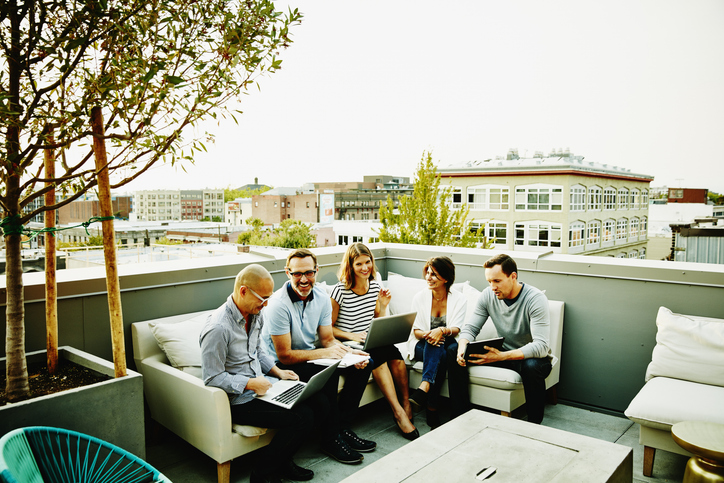Most of us want to spend more time outside as the weather gets warmer. When it comes to facilities, facilities managers can maximize their outdoor spaces by working with their employers, other departments, and outside contractors to tailor unique solutions to their business. This, in turn, could encourage more employees to return to the office and more customers to patronize their business.

How Can Outdoor Spaces Be Used?
Outdoor spaces can be used in three main ways:
1. Events and Meetings
Businesses should use outdoor spaces for hosting events like conventions, banquets, festivals, receptions, and meetings.
Those that host large-scale events should consider renting portable toilets.
Open-air venues that could be built, or redesigned, include:
- Balconies
- Parks
- Parking lots
- Patios
- Pavilions
- Terraces
- Urban rooftops
According to the New York Times, some New York City office complexes have rooftop terraces and balconies on each floor with various forms of vegetation, like native grasses and trees, and employed landscape architectural companies to aid in design.
Additionally, facilities professionals should ensure there’s Wi-Fi service and weather-friendly wired power poles with USB capabilities.
All facilities should also consider replacing a wall with a roll-up door to create a half-in, half-out conference room.
In a study reported on by the National Library of Medicine, outdoor office work led to enhanced cognition and better communications.
2. Outdoor Recreation
Providing passive and active recreational areas can increase socialization and teambuilding.
Consider building basketball, bocce ball, and pickleball courts and an outdoor fitness area with exercise equipment.
For those who are into passive recreation, consider using outdoor areas to design and create:
- Biking paths
- Walking areas
- Scenic overlooks
Facilities professionals could also install sidewalks, educational signage about nature or history along walking paths, and small mileage markers, as well as design and build trail bridges over wetlands or lakes.
Rest areas with benches, gazebos, bike racks, water fountains, and bottle-filler stations should be considered, as well.
Learn the importance of building pedestrian barriers, including bollards, to prevent vehicles from entering recreation areas by reading “Back to Basics: Using Bollards for Security and Safety” on Facilities Management Advisor.
3. Dining
Customers and employees like to dine outside at restaurants and their workplaces.
When designing and constructing outdoor spaces, consider following some of the National Restaurant Association’s recommendations:
- Obtain required permits, which may include construction and seating-capacity figures.
- Control pests by having well-maintained landscaping, eliminating standing water, setting up bug zappers, and performing thorough cleaning.
- Add trash receptacles and hand-sanitizing stations.
- Set up tabletop candles, battery lamps, and spotlighting.
- Install a self-closing door or an air curtain over the door leading to dining areas to keep elements and pests outside.
All types of businesses should consider having outdoor grilling stations, beverage stations, or buffets for special events. Additionally, think about having food trucks park near outdoor dining spaces.
When building an outdoor dining space, consider purchasing benches, picnic tables, patio furniture, or other weatherproof outdoor furniture.
Additional Considerations
Here are three additional factors facilities professionals should keep in mind:
1. Weather
In the event of light rain, facilities professionals should have tents available.
Items that could help with bright sun and hot temperatures include awnings, curtains, umbrellas, and fan misters. You could also provide heating lamps when it’s cold outside.
As for inclement weather, have a backup plan that includes a large indoor space.
2. Americans with Disabilities Act (ADA)
Outdoor spaces must be as accessible as possible, not only so all employees and customers can enjoy them but also to adhere to ADA requirements. To learn more, check out “Back to Basics: The ADA’s Impact on Facility Compliance” on Facilities Management Advisor.
3. Sound
If installing speakers outside, check with the local municipality to see if there’s a sound ordinance that may limit sound levels based on the time of day.
Conclusion
Using your outdoor spaces for events, meetings, outdoor recreation, and dining is an excellent way for employees and customers to get some fresh air. Consider how you can handle various types of weather, as well as comply with the ADA and sound ordinances, when building your outdoor spaces.
